
Euclid peers into the dark areas of our universe
On February 14, 2024, ESA’s Euclid space telescope began its six-year mission to “observe billions of galaxies and 10 billion years of cosmic history.” Its goal is to survey 1/3 of the night sky in visible and near-infrared light outside the bright Milky Way. These observations should help astronomers better understand the universe’s expansion and structure over time, providing insight to the nature of dark matter and dark energy. Euclid launched from Florida on July 1, 2023. It’s now up and running at its home at Lagrange point 2, 930,000 miles (1.5 million km) from Earth. You may be familiar with Lagrange 2 as the home of the Webb Space Telescope.
In just the first two weeks, Euclid will survey an area greater than 500 times the size of the full moon. This first region it’s observing is in the direction of the Southern Hemisphere constellations of Caelum and Pictor.
Euclid is named after an ancient Greek mathematician.
Euclid can catch 50,000 galaxies in one shot
Covering 1/3 of the sky in six years means Euclid has a lot of territory to cover. Fortunately, it can image a patch of sky larger than the full moon in one shot. The moon is 0.5 degrees wide, and Euclid’s vision is 0.7 by 0.7 degrees. In each patch of sky this size, Euclid could be imaging around 50,000 galaxies. Euclid will stare at each one of these patches for about 70 minutes, before moving on to the next patch of sky.
Roberto Scaramella, Euclid survey scientist at the National Institute for Astrophysics (INAF) in Italy, said:
Thanks to its wide-eyed look at the cosmos, and its long exposure time and sensitivity, the number of galaxies that Euclid can see in one pointing is huge. To study the individual distortions of galaxies by dark matter, we need to observe at least 1.5 billion galaxies. Euclid will observe the shapes of around 50,000 galaxies with the needed accuracy in one shot, and will spot many more faint ones.
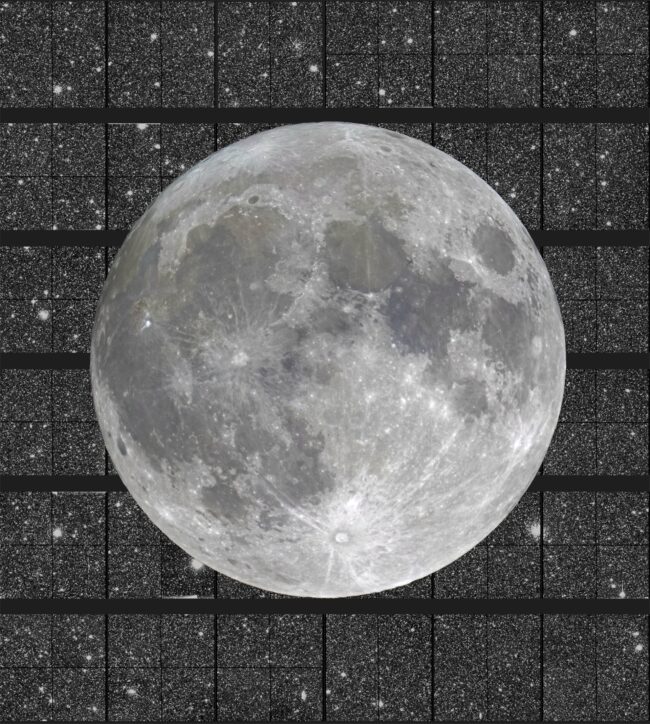
Encountering an early problem
Soon after Euclid began its test imaging, scientists noticed a problem. A tiny amount of unwanted sunlight was reaching Euclid’s visible instrument (VIS) at specific angles. And that was even with the spacecraft’s back turned toward the sun.
Ismael Tereno of the University of Lisbon, Portugal, said:
The original plan was for Euclid to keep its sunshield facing the sun. But soon after launch, we detected disturbing light from the sun in the test images.
João Dinis, also from the University of Lisbon, Portugal, said:
After intense troubleshooting, science, engineering, and industrial teams found that for this light to disappear, Euclid needed to observe with a different orientation (attitude) with respect to the sun. This meant that the original survey design would no longer work. We had to quickly come up with a new strategy, implement it, and test it.
But, with this new restricted attitude, there were parts of the sky Euclid could not observe from any point in its orbit. Eventually, the best solution was to have more overlaps between adjacent observations. Euclid’s survey is now a bit less efficient, but all necessary areas of the sky can be reached. The overall loss in survey area is kept to a minimum.
Euclid’s mission to survey the dark universe
Dark matter and dark energy are two huge fundamental holes in our understanding of the universe. Dark matter makes up about 25% of the universe, but we don’t know what it is. Moreover, we only know it exists because we can see the effects it has on other objects. And nearly 70% of the universe seems to be made of dark energy, an unknown force that is causing the universe to expand. (A recent study said perhaps black holes are the source of dark energy.) That leaves the ordinary matter we see – stars and galaxies, etc. – as only about 5% of the universe.
Euclid is looking to address five mysteries:
- What is the structure and history of the cosmic web?
- What is the nature of dark matter?
- How has the expansion of the universe changed over time?
- What is the nature of dark energy?
- Is our understanding of gravity complete?
Instruments onboard
Euclid has two science instruments. The first is a visible-wavelength camera, or VIS. Also, it has a near-infrared spectrometer and photometer, or NISP. Euclid will provide imaging in visible wavelengths, plus spectroscopy and photometry in near-infrared. Learn more about Euclid’s instruments in the illustration below.
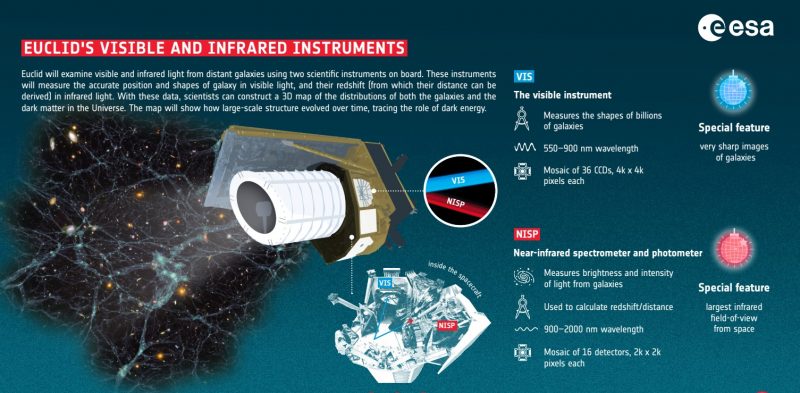
What will the Euclid mission see and measure?
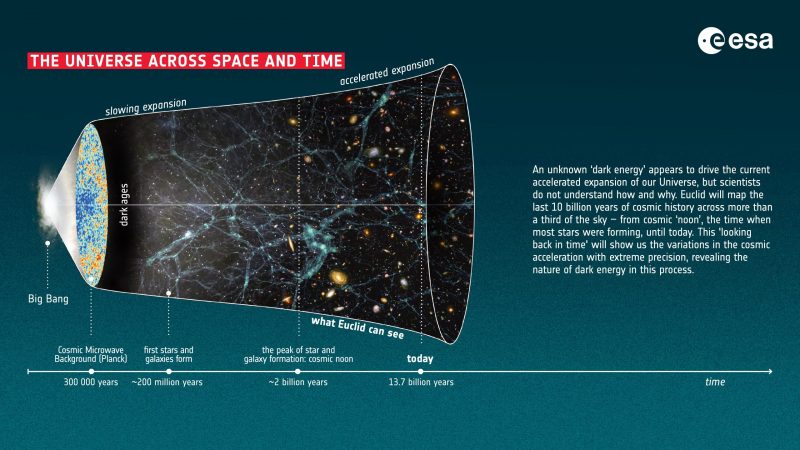
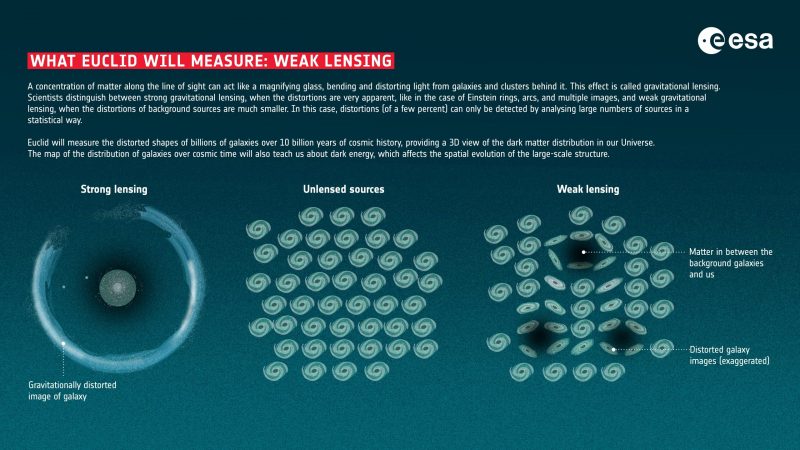

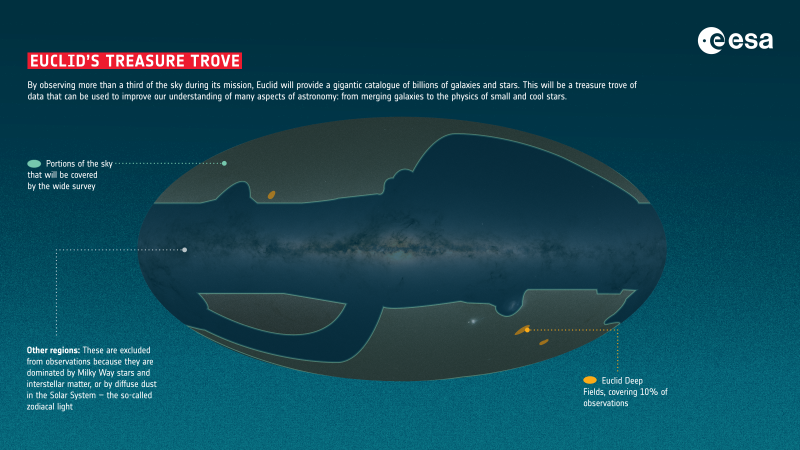
Bottom line: On February 14, 2024, Euclid began its mission of surveying the dark universe. The space telescope will observe about 1/3 of the sky.











